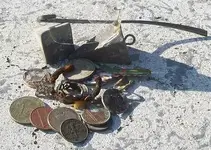bigscoop
Gold Member
- Joined
- Jun 4, 2010
- Messages
- 13,541
- Reaction score
- 9,086
- Golden Thread
- 0
- Location
- Wherever there be treasure!
- Detector(s) used
- Older blue Excal with full mods, Equinox 800.
- Primary Interest:
- All Treasure Hunting
Here you go, a real hunter scenario I’m mauling over. How would you attack this situation?
This is coastal, east coast of Florida where there is always current and surf to be dealt with. At present it is the monthly high tide cycle so there is more water volume on the move even at low tide. The wind is out of the east, northeast, which only adds to the problem. But here's the positive, because of the extra water volume and change in current flow the sand is moving and I’ve located a few deep cuts just before the typical low waterline, however, these deep cuts won’t be there for long and the conditions have created a very deep uneven bottom that is pocketed with holes. When I say deep I mean chin deep with the extra push of water. I was in them yesterday without a machine just to check them out and though the current and surf is going to make it difficult to hunt there isn’t enough current and surf at low tide to pose a serious danger. These are not rips, just deep cuts that have been formed in the past several days.
Decisions, decisions. I’m probably only going to get one or two very short hunting opportunities before these start to fill back in, so, and because of the uneven bottom and constant buoyancy issues, would you go with the large coil for maximum coverage, or would you go with the small coil for better control and maneuverability over the uneven bottom? A tight, controlled hunting pattern probably isn’t going to be possible but a larger coil is probably going to be a real pain over the uneven bottom. Decisions, decisions. How would you attack these cuts? As soon as this extra water volume starts to slack off these cuts will fill right back in so it’s either hunt them now or forget about them. I plan on hitting them Thursday and Friday at low tide.
PS: No weight belt.
This is coastal, east coast of Florida where there is always current and surf to be dealt with. At present it is the monthly high tide cycle so there is more water volume on the move even at low tide. The wind is out of the east, northeast, which only adds to the problem. But here's the positive, because of the extra water volume and change in current flow the sand is moving and I’ve located a few deep cuts just before the typical low waterline, however, these deep cuts won’t be there for long and the conditions have created a very deep uneven bottom that is pocketed with holes. When I say deep I mean chin deep with the extra push of water. I was in them yesterday without a machine just to check them out and though the current and surf is going to make it difficult to hunt there isn’t enough current and surf at low tide to pose a serious danger. These are not rips, just deep cuts that have been formed in the past several days.
Decisions, decisions. I’m probably only going to get one or two very short hunting opportunities before these start to fill back in, so, and because of the uneven bottom and constant buoyancy issues, would you go with the large coil for maximum coverage, or would you go with the small coil for better control and maneuverability over the uneven bottom? A tight, controlled hunting pattern probably isn’t going to be possible but a larger coil is probably going to be a real pain over the uneven bottom. Decisions, decisions. How would you attack these cuts? As soon as this extra water volume starts to slack off these cuts will fill right back in so it’s either hunt them now or forget about them. I plan on hitting them Thursday and Friday at low tide.
PS: No weight belt.
Upvote
0



 Come to think of it, it's only very seldom that I ever see another hunter beyond the breakers or waterline even during the calmer low tides of summer.
Come to think of it, it's only very seldom that I ever see another hunter beyond the breakers or waterline even during the calmer low tides of summer.

